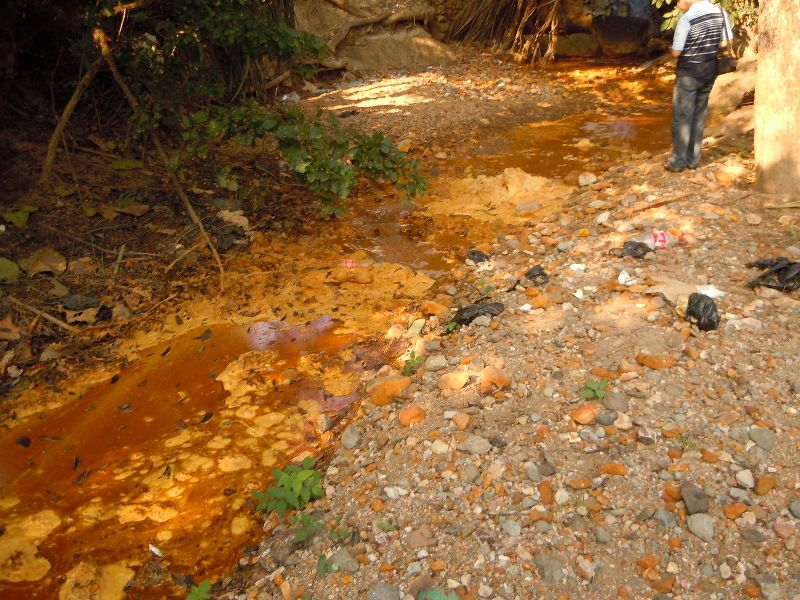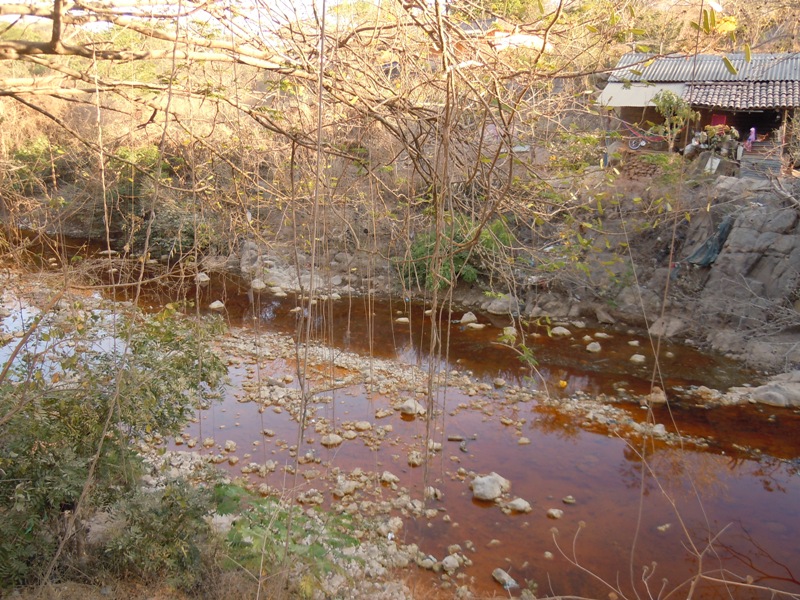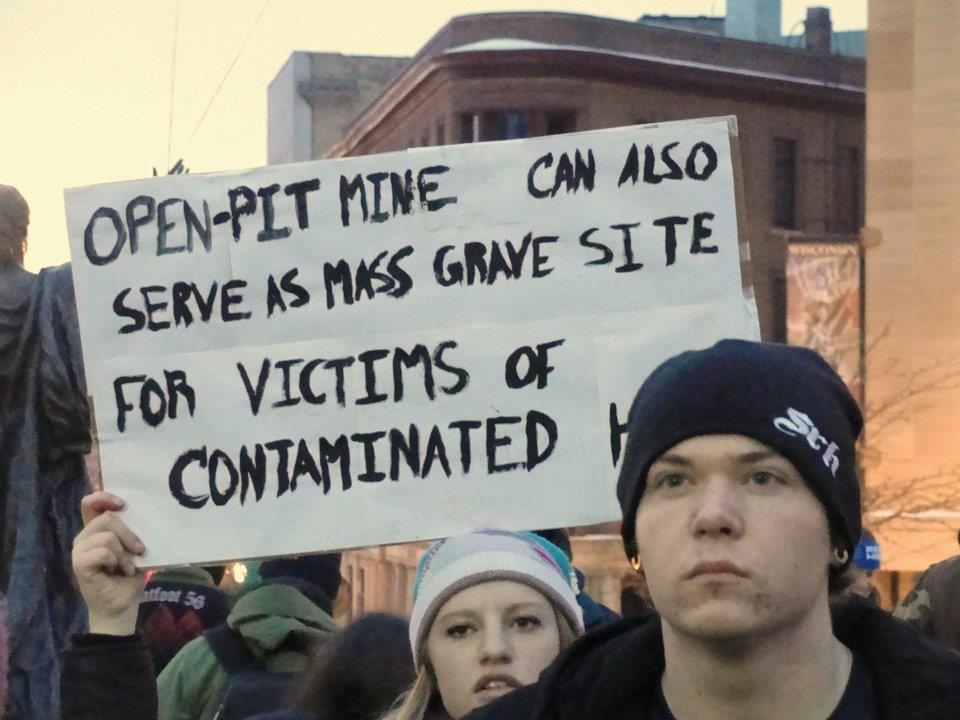Salvadoran Mining Struggles are Pertinent to Wisconsin
- Details
-
Published: Friday, 27 April 2012 15:06
Salvadoran Mining Struggles are Pertinent to Wisconsin
by A. David Dahmer,
April 25, 2012

Jan Morrill, of the National Roundtable Against Metallic Mining, is on a national tour talking about important mining issues.
The recent mining controversy in northern Wisconsin was far more complex than people would have you believe, says Jan Morrill as she stopped in Madison as part of a national tour she was embarking on. Morrill, who works for the National Roundtable Against Metallic Mining, is actively working to build international alliances on the issue of mining.
Morrill spoke from her own extensive experience on building U.S.-El Salvador ties in a talk called “Globalizing Mining Resistance” April 11 at Helen C. White Hall on the University of Wisconsin-Madison campus.
Morrill has been directly working with communities resisting mining in El Salvador for four years and is currently the representative of the International Allies against Metallic Mining in El Salvador, a coalition of organizations in the U.S. and Canada working to support the struggles of Salvadoran communities for sovereignty over their natural resources. In her work, she coordinates closely with the National Roundtable against Metallic Mining, national organizations in El Salvador, and the communities that have been and would be directly affected by gold mining.
“I've been talking about patterns in the international mining industry and how what happened here in Wisconsin is not unique to here,” she tells The Madison Times in an interview at Ground Zero Coffee shop. “That's what has been happening in El Salvador, Honduras, Guatemala, and South America, the Philippines.”
Mining companies have come to communities in El Salvador, and now in Wisconsin, touting jobs and "environmentally safe mining" which uses, they claim, new technology and new techniques. But what they say is very different from what Morrill says she has seen firsthand.
Read the rest of the article here….

While There is a Slight Increase in Water Quality, the Situation is still Critical
- Details
-
Published: Saturday, 31 March 2012 13:30
While There is a Slight Increase in Water Quality, the Situation is still Critical
River Water Quality Improves, says MARN
The water classified as “good” in rivers increased 2 per cent, to 12 percent in 2011.
By Gloria Morán
Diario Contra Punto
San Salvador- With its report “River Quality in El Salvador, 2011” the Ministry of the Environment and Natural Resources (MARN) revealed that the water in Salvadoran rivers showed a tendency of improved water quality.
The studies were carried out between April and June of 2011, and the MARN took 123 samples from 55 rivers, including the Paz River, the Grande River in Sonsonate, the Bahia River in Jiquilisco, the Grande River in San Miguel, as well as others.
The information collected showed that none of the rivers had “excellent” water quality, that 12 percent had “good” quality, which shows an increase from 10 percent in 2010; that 50 percent had “average” quality; that 31 percent had “poor” quality, and 7 percent had “terrible” quality. One of the major findings is that according to the study the Lempa Rivera improved in water quality in the Northern regions of the country. The improved water quality has provided the conditions for the more aquatic life.
The head of the MARN, Herman Rosa Chazez, said that improved water quality can be attributed to the work done by the ministry in sewer and other waste treatment; for example collecting tires, compost sites, and sewer treatment, among others.
Domestic water is the most contaminated
However, he empathized that while it is true that there has been an increase in the river water considered “good,” that is not enough and he affirmed that the Government will invest more resources in treating sewer water.
According to Celia Mena, hydrologist with the MARN, this investment is necessary because the water coming from domestic use is the most contaminating to rivers.
“This type of pollution can be seen by the presence of high concentrations of Coli form fecal bacteria in the water. During the study, there were concentrations of 3,500,00 bacteria/100 mL found,” says the MARN report. Celina affirmed that “the water quality of the majority of rivers is deficient for conventional potable water standards,” referring to the fact that only 17 percent of river water can be made drinkable by taking steps like adding bleach, boiling or filtering water. “The quality of river water is improving,” said Rosa Chavez, when he compared the results with those in 2009 where none of water could be classified as “good”.
Other Results
Other results found by the study were that only 26 percent of river water can be used for crop irrigation.
Of the 123 sample sites on a national level, only 26% met irrigation standards, “the other 74% don’t meet the requirements for irrigation due to the high levels of fecal Coli forms, with conductivity levels up to 1319 uS/cm and some areas with elevated levels of sodium and sulfates.”
According to the study, the rivers that meet irrigation standards are the Lempa River and the San Simón River that provide water for the Lempa Acahuapa Irrigation District. While those which didn’t meet the standards are the Sucio River which supplies the Zapotitan Irrigation District with water, the Lempa River in the Northern District and the Acahuapa River that supplies the Lempa Acahuapa District.
The study showed poor water quality for recreational activities, indicating that only 0.08 percent can be used for recreation, while in 2010 the report showed that 6 percent was adequate for recreation.
“This is not a new situation [the river pollution] and that is why we need more investment and commitment from the Government,” said the head of MARN.
For the original in Spanish

Yes to Life, No to Mining
- Details
-
Published: Friday, 23 March 2012 12:42
“Yes” to Life, “No” to Mining
Wednesday, February 29, 2012 / 10:09 am
By, Carlos Chita, Diario Co Latino Editorials
Translated by Jan Morrill
That Congress puts the Executive Branch’s political will to the test, by passing a Law that would definitively ban mining exploration and exploitation in El Salvador, is the demand being made by the National Roundtable against Metallic Mining (Mesa in Spanish) towards the different legislative political parties.
The beginning of the last stage of negotiations of the Free Trade Agreement between El Salvador and Canada has put those who defend natural resources in our country in a state of alert, because they consider the agreement to be in favor of mining, based on the fact that, currently, trade between the two countries is no more than $16 million a year, which does not represent a necessary market for either country.
They remind people that 30% of the world mining industry is from Canada and that this agreement, of which 85% has already been negotiated in complete secrecy, is an opportunity for transnational Canadian companies to take precious metals from our subsoil.
Mining exploration began in El Salvador in 1880, and was carried out in the northeastern part of the country for almost 100 years, even though at its highest it only represented 16% of all exportations (1913) and it was never a significant contribution to development. However, the environmental damages produced by are the process still being felt, the most emblematic case being the San Sebastian River in Santa Rosa de Lima.
The new gold fever began in 1995, with the enactment of the current Mining Law, which to date has taken five lives and forced a journalist from Radio Victoria into exile, as well as caused the downfall of the inhabitants of the area Pacific Rim has decided to explore.
The National Roundtable against Metallic Mining insists that the issue of metallic mining needs solutions and urgent response from decision makers in government positions, political parties and, finally, the Legislative Assembly; and that approval of a law that would ban metallic mining is urgent and strategic in the short term.
The original text in Spanish here.

Lucha Continental: Lazos Anti-Mineros de Wisconsin y El Salvador
- Details
-
Published: Tuesday, 28 February 2012 11:28
Lucha Continental: Lazos Anti-Mineros de Wisconsin y El Salvador

Febrero, 2012
English Version
La lucha contra la minería se está intensificando en el estado de Wisconsin, EEUU. El jueves 26 de enero, la cámara de representantes estatal deWisconsin (dominado por miembros del partido de derecha Republicana) aprobó una ley que facilitaría el proceso de otorgar permisos para minería de hierro en el estado. La propuesta de ley se llama AB 426, y ahora pasa al senado estatal para un segundo voto (toda propuesta de ley en los EEUU tiene que ser aprobado por la Cámara de Representantes y después el Senado, sea al nivel de estado o al nivel nacional).
Actualmente, las compañías mineras están planteando dos tipos de extracción minera en Wisconsin: minería de arena, la cual se ocupa para el proceso de producción de gas natural, y minería de hierro. Gogebic Taconite, una compañía minera estadounidense, está buscando abrir una mina de hierro en el norte de Wisconsin que valdría $12 mil millones. El proyecto contempla una mina a cielo abierto que rodearía 35.4 kilómetros.
La mina amenaza contaminar la Cuenca del Bad River, que es la principal fuente de agua para la cuidad cercana de Ashland y los cultivos de arroz nativo del pueblo indígena Ojibwe del Bad River. En los EEUU, la tierra de una tribu de un pueblo indígena se considera como una nación soberana, y existen acuerdos entre la el gobierno de los EEUU y las naciones indígenas soberanas. Uno de los acuerdos con la nación de los Ojibwe establece que no se permite la contaminación de los recursos naturales, y al abrir este proyecto minero, el acuerdo está en peligro de romperse, lo cual está contemplado como “acto de guerra.”
Mientras los legisladores debatieron la propuesta de ley, los pueblos indígenas, algunos que habían viajado más de 400 km para participar, junto con otras organizaciones e individuos preocupados por la minería, organizaron una “Audiencia del Pueblo” donde escucharon testimonio sobre los posibles impactos de la minería en su estado y sobre la oposición del pueblo a estos proyectos. En una conferencia de prensa el Presidente Tribal Mike Wiggains, Jr, dijo “Esta propuesta de ley representa los intereses de las empresas más que los derechos de los ciudadanos y más que los intereses de tener agua y aire limpios.”
 Durante la “Audiencia del Pueblo,” también, se dio lectura a un saludo mandado por Kenia Ortez en nombre de la comunidad de San Sebastian en Santa Rosa de Lima, La Unión, El Salvador. Hay un vínculo fuerte entre Wisconsin y El Salvador en términos de minería. Actualmente, una empresa minera deWisconsin está intentando demandar al gobierno de El Salvador por $100 millones, después de que el gobierno revocó sus permisos de explotación cuando la comunidad donde está ubicada la mina, San Sebastian, presentó evidencia de una fuerte contaminación del medioambiente como resultado del proceso de minería. En su saludo, Ortez dijo “Solo queremos decirles que no quisiéramos que ninguna comunidad, ningún pueblo, sufra lo que nosotros estamos sufriendo por la explotación de la minería.”
Durante la “Audiencia del Pueblo,” también, se dio lectura a un saludo mandado por Kenia Ortez en nombre de la comunidad de San Sebastian en Santa Rosa de Lima, La Unión, El Salvador. Hay un vínculo fuerte entre Wisconsin y El Salvador en términos de minería. Actualmente, una empresa minera deWisconsin está intentando demandar al gobierno de El Salvador por $100 millones, después de que el gobierno revocó sus permisos de explotación cuando la comunidad donde está ubicada la mina, San Sebastian, presentó evidencia de una fuerte contaminación del medioambiente como resultado del proceso de minería. En su saludo, Ortez dijo “Solo queremos decirles que no quisiéramos que ninguna comunidad, ningún pueblo, sufra lo que nosotros estamos sufriendo por la explotación de la minería.”
Para fotos de la “Audiencia del Pueblo” y la protesta visita aquí.
Los pueblos indígenas de Wisconsin tienen una larga trayectoria de lucha contra la minería. El pueblo Ojibwe luchó por décadas, y finalmente ganó en 2003, contra empresas que buscaron construir una mina de cobre y zinc. Al final, gastaron $16.5 millones y compraron el sitio de la minería de la empresa Nicolet Minerals Inc.
Aun con su historia de lucha, la reacción a las actividades que han organizado de parte del gobierno estatal y la policía les ha sorprendido. Durante la “Audiencia del Pueblo” uno de los activistas fue detenido por “crear disturbios” al tocar un tambor indígena. Recientemente, el gobierno estatal ha cambiado las regulaciones sobre actividades de protesta. “Hemos perdido más libertades en este país en los últimos cuatro décadas que durante toda la historia de los Estados Unidos, especialmente con respeto a las primera y cuarta enmiendas. Fíjense en la Ley Patriota,” denunció Joe Rose, líder del Bad River Band.
Para más información en inglés sobre las protestas, visita aquí, aquí y aquí
Saludo de Kenia Ortez en nombre de la comunidad de San Sebastian, Santa Rosa de Lima, La Unión
Queridos amigos de Wisconsin
Reciban un cordial saludo de solidaridad, de parte de la comunidad San Sebastián de Santa Rosa de Lima, El Salvador.
 Queremos solidarizarnos con el pueblo de Wisconsin en su lucha contra la mina, ya que no es una lucha individual, sino colectiva. Es una lucha de países que debemos estar siempre alerta y en una lucha constante a estas empresas mineras, que solo causan daño y destrucción a las comunidades o pueblos. Nosotros hablamos de estos daños y destrucciones porque los hemos vivido en carne propia. Hemos vivido y estamos viviendo las consecuencias de la explotación de una mina.
Queremos solidarizarnos con el pueblo de Wisconsin en su lucha contra la mina, ya que no es una lucha individual, sino colectiva. Es una lucha de países que debemos estar siempre alerta y en una lucha constante a estas empresas mineras, que solo causan daño y destrucción a las comunidades o pueblos. Nosotros hablamos de estos daños y destrucciones porque los hemos vivido en carne propia. Hemos vivido y estamos viviendo las consecuencias de la explotación de una mina.
Nos comentan que ustedes tendrán una audiencia el miércoles en el capitolio estatal hoy.
Solo queremos decirles que no quisiéramos que ninguna comunidad, ningún pueblo, sufra lo que nosotros estamos sufriendo por la explotación de la minería.
Así que adelante con su lucha
Comunidad de San Sebastián
24 de enero de 2012






 Durante la “Audiencia del Pueblo,” también, se dio lectura a un saludo mandado por Kenia Ortez en nombre de la comunidad de San Sebastian en Santa Rosa de Lima, La Unión, El Salvador. Hay un vínculo fuerte entre Wisconsin y El Salvador en términos de minería. Actualmente, una empresa minera deWisconsin está intentando demandar al gobierno de El Salvador por $100 millones, después de que el gobierno revocó sus permisos de explotación cuando la comunidad donde está ubicada la mina, San Sebastian, presentó evidencia de una fuerte contaminación del medioambiente como resultado del proceso de minería. En su saludo, Ortez dijo “Solo queremos decirles que no quisiéramos que ninguna comunidad, ningún pueblo, sufra lo que nosotros estamos sufriendo por la explotación de la minería.”
Durante la “Audiencia del Pueblo,” también, se dio lectura a un saludo mandado por Kenia Ortez en nombre de la comunidad de San Sebastian en Santa Rosa de Lima, La Unión, El Salvador. Hay un vínculo fuerte entre Wisconsin y El Salvador en términos de minería. Actualmente, una empresa minera deWisconsin está intentando demandar al gobierno de El Salvador por $100 millones, después de que el gobierno revocó sus permisos de explotación cuando la comunidad donde está ubicada la mina, San Sebastian, presentó evidencia de una fuerte contaminación del medioambiente como resultado del proceso de minería. En su saludo, Ortez dijo “Solo queremos decirles que no quisiéramos que ninguna comunidad, ningún pueblo, sufra lo que nosotros estamos sufriendo por la explotación de la minería.”